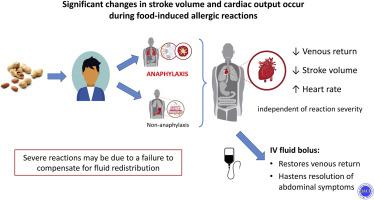Journal of Allergy and Clinical Immunology ( IF 11.4 ) Pub Date : 2020-07-21 , DOI: 10.1016/j.jaci.2020.06.033 Monica Ruiz-Garcia 1 , Joan Bartra 2 , Olaya Alvarez 1 , Ashna Lakhani 1 , Shalinee Patel 1 , Alistair Tang 1 , Marcus Sim 1 , Mohamed H Shamji 1 , Isabel Skypala 3 , E N Clare Mills 4 , Alexander R Lyon 5 , Carl Hayward 6 , Stephen R Durham 3 , Paul J Turner 1 , Robert J Boyle 1

|
Background
Food allergy is the most common cause of anaphylaxis. Changes in posture during acute reactions can trigger fatal outcomes, but the impact of allergic reactions on the cardiovascular system in nonfatal reactions remains poorly understood.
Objective
Our aim was to systematically evaluate changes in cardiovascular function during acute allergic reactions to peanut.
Methods
Participants underwent double-blind placebo-controlled food challenge to peanut as part of a clinical trial. Changes in hemodynamic parameters (heart rate, stroke volume, blood pressure, and peripheral blood flow) and electrocardiogram findings during food challenges were assessed using noninvasive continuous monitoring.
Results
A total of 57 adults (median age 24 years [interquartile range = 20-29]), 53% of whom were female, participated; 22 (39%) had anaphylaxis. Acute reactions were associated with significant changes in stroke volume (mean decrease of 4.2% [95% CI = 0.8-7.6; P = .03]), heart rate (mean increase 11.6% [95% CI = 8.4-14.8; P < .0001]), and peripheral blood flow (mean increase 19.7% [95% CI = 10.8-28.6; P < .0001]), irrespective of reaction severity. These changes were reproduced at a subsequent repeat peanut challenge in 26 participants, and could be reversed with administration of intravenous fluids which resulted in faster resolution of abdominal symptoms.
Conclusions
In this first detailed human study of cardiovascular changes during food-induced allergic reactions, we found evidence for significant fluid redistribution, independent of reaction severity. This provides a sound rationale for optimizing venous return during significant allergic reactions to food. Finally, these data provide a new paradigm for understanding severity in anaphylaxis, in which poor outcomes may occur as a result of a failure in compensatory mechanisms.
中文翻译:

花生引起的人体过敏反应期间心血管的变化
背景
食物过敏是过敏反应的最常见原因。急性反应期间姿势的变化可能引发致命的后果,但过敏反应在非致命反应中对心血管系统的影响仍然知之甚少。
客观的
我们的目的是系统评估花生急性过敏反应期间心血管功能的变化。
方法
作为临床试验的一部分,参与者接受了双盲安慰剂对照花生食物挑战。使用无创连续监测评估食物挑战期间血流动力学参数(心率、每搏输出量、血压和外周血流量)和心电图结果的变化。
结果
共有 57 名成年人(中位年龄 24 岁 [四分位距 = 20-29])参与,其中 53% 为女性; 22 人(39%)有过敏反应。急性反应与每搏输出量(平均下降 4.2% [95% CI = 0.8-7.6; P = .03])、心率(平均增加 11.6% [95% CI = 8.4-14.8; P % 3C .0001])和外周血流量(平均增加 19.7% [95% CI = 10.8-28.6; P < .0001]),无论反应严重程度如何。这些变化在随后的 26 名参与者重复花生挑战中得到了重现,并且可以通过静脉输液来逆转,从而更快地缓解腹部症状。
结论
在这项首次针对食物引起的过敏反应期间心血管变化的详细人体研究中,我们发现了明显的液体重新分布的证据,而与反应的严重程度无关。这为在食物发生严重过敏反应期间优化静脉回流提供了合理的理由。最后,这些数据为理解过敏反应的严重程度提供了一个新的范例,其中补偿机制的失败可能会导致不良的结果。











































 京公网安备 11010802027423号
京公网安备 11010802027423号